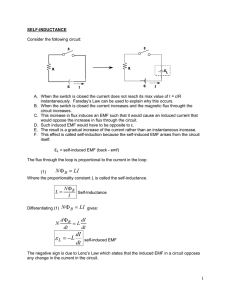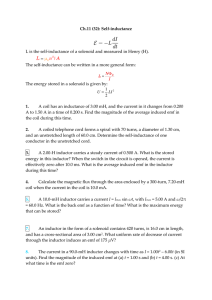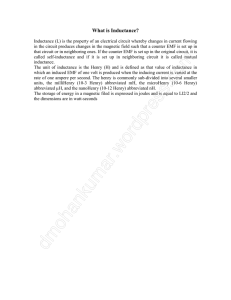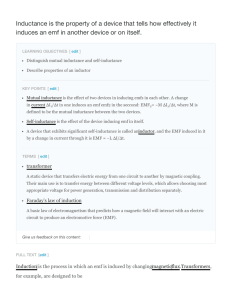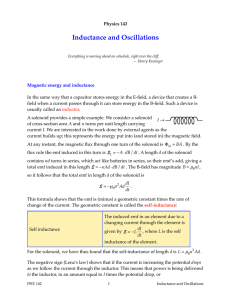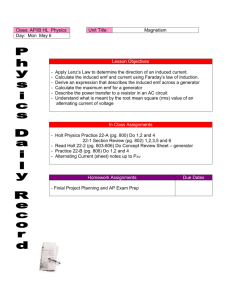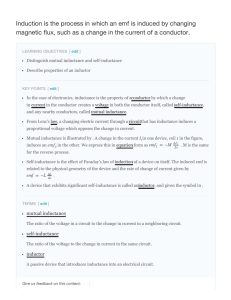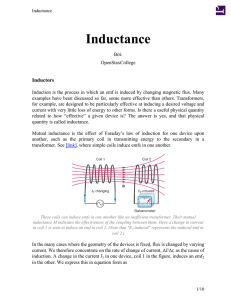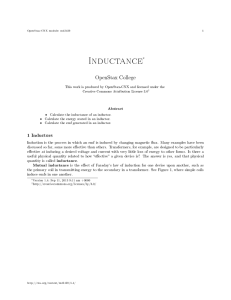Physics 10-09 Inductance
advertisement
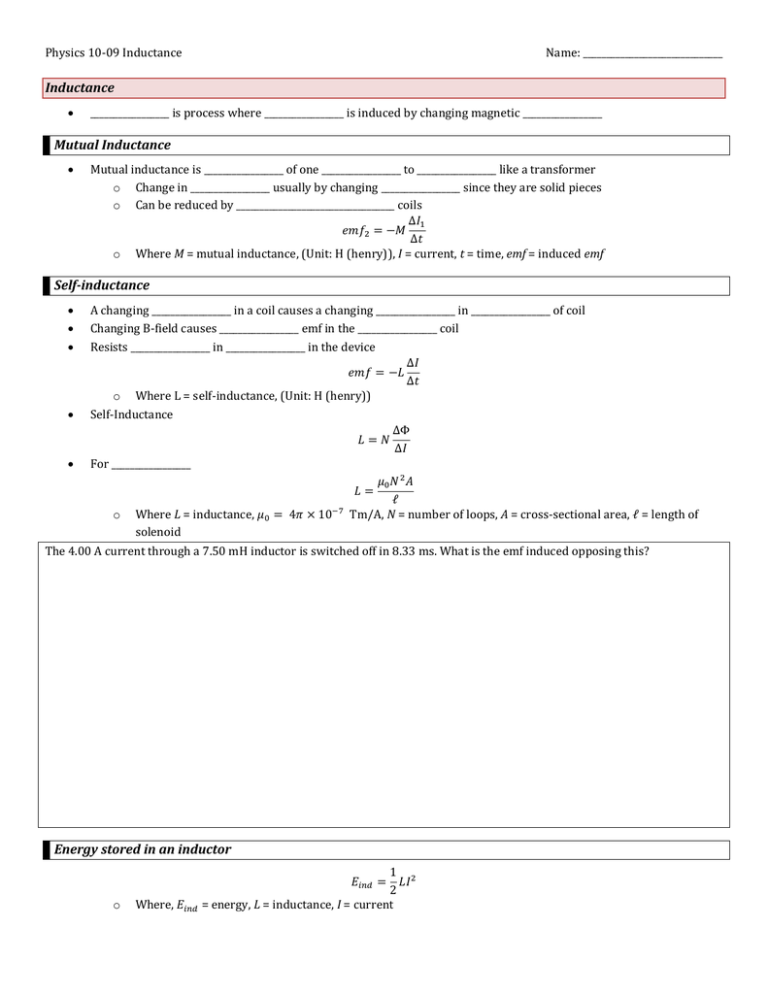
Physics 10-09 Inductance Name: ______________________________ Inductance _________________ is process where _________________ is induced by changing magnetic _________________ Mutual Inductance Mutual inductance is _________________ of one _________________ to _________________ like a transformer o Change in _________________ usually by changing _________________ since they are solid pieces o Can be reduced by __________________________________ coils Δ𝐼1 𝑒𝑚𝑓2 = −𝑀 Δ𝑡 o Where M = mutual inductance, (Unit: H (henry)), I = current, t = time, emf = induced emf Self-inductance A changing _________________ in a coil causes a changing _________________ in _________________ of coil Changing B-field causes _________________ emf in the _________________ coil Resists _________________ in _________________ in the device Δ𝐼 𝑒𝑚𝑓 = −𝐿 Δ𝑡 o Where L = self-inductance, (Unit: H (henry)) Self-Inductance ΔΦ 𝐿=𝑁 Δ𝐼 For _________________ 𝜇0 𝑁 2 𝐴 𝐿= ℓ o Where L = inductance, 𝜇0 = 4𝜋 × 10−7 Tm/A, N = number of loops, A = cross-sectional area, ℓ = length of solenoid The 4.00 A current through a 7.50 mH inductor is switched off in 8.33 ms. What is the emf induced opposing this? Energy stored in an inductor 1 2 𝐿𝐼 2 Where, 𝐸𝑖𝑛𝑑 = energy, L = inductance, I = current 𝐸𝑖𝑛𝑑 = o Physics 10-09 Inductance Name: ______________________________ Homework 1. How would you place two identical flat coils in contact so that they had the greatest mutual inductance? The least? 2. How would you shape a given length of wire to give it the greatest self-inductance? The least? 3. Two coils are placed close together in a physics lab to demonstrate Faraday’s law of induction. A current of 5.00 A in one is switched off in 1.00 ms, inducing a 9.00 V emf in the other. What is their mutual inductance? (OpenStax 23.55) 1.80 mH 4. If two coils placed next to one another have a mutual inductance of 5.00 mH, what voltage is induced in one when the 2.00 A current in the other is switched off in 30.0 ms? (OpenStax 23.56) 0.333 V 5. A device is turned on and 3.00 A flows through it 0.100 ms later. What is the self-inductance of the device if an induced 150 V emf opposes this? (OpenStax 23.58) 5.00 mH 6. Camera flashes charge a capacitor to high voltage by switching the current through an inductor on and off rapidly. In what time must the 0.100 A current through a 2.00 mH inductor be switched on or off to induce a 500 V emf? (OpenStax 23.60) 𝟒. 𝟎𝟎 × 𝟏𝟎−𝟕 s 7. A large research solenoid has a self-inductance of 25.0 H. (a) What induced emf opposes shutting it off when 100 A of current through it is switched off in 80.0 ms? (b) How much energy is stored in the inductor at full current? (c) At what rate in watts must energy be dissipated to switch the current off in 80.0 ms? (d) In view of the answer to the last part, is it surprising that shutting it down this quickly is difficult? (OpenStax 23.61) 31.3 kV, 𝟏. 𝟐𝟓 × 𝟏𝟎𝟓 J, 1.56 MW, no 8. (a) Calculate the self-inductance of a 50.0 cm long, 10.0 cm diameter solenoid having 1000 loops. (b) How much energy is stored in this inductor when 20.0 A of current flows through it? (c) How fast can it be turned off if the induced emf cannot exceed 3.00 V? (OpenStax 23.62) 19.7 mH, 3.95 J, 0.132 s 9. A precision laboratory resistor is made of a coil of wire 1.50 cm in diameter and 4.00 cm long, and it has 500 turns. (a) What is its self-inductance? (b) What average emf is induced if the 12.0 A current through it is turned on in 5.00 ms (onefourth of a cycle for 50 Hz AC)? (c) What is its inductance if it is shortened to half its length and counterwound (two layers of 250 turns in opposite directions)? (OpenStax 23.63) 1.39 mH, -3.33 V, 0 10. The heating coils in a hair dryer are 0.800 cm in diameter, have a combined length of 1.00 m, and a total of 400 turns. (a) What is their total self-inductance assuming they act like a single solenoid? (b) How much energy is stored in them when 6.00 A flows? (c) What average emf opposes shutting them off if this is done in 5.00 ms (one-fourth of a cycle for 50 Hz AC)? (OpenStax 23.64) 𝟏. 𝟎𝟏 × 𝟏𝟎−𝟓 H, 𝟏. 𝟖𝟐 × 𝟏𝟎−𝟒 J, 12.12 mV

